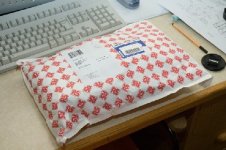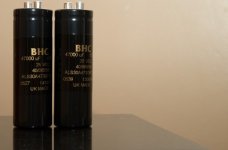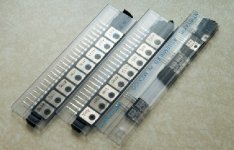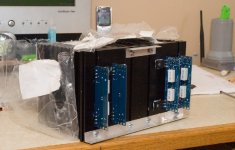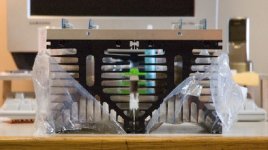Banned
Joined 2002
I assume you use thermal grease.
Do you have mica insulation in between (I would recommend) ?
Use the thermal grease sparringly. You should only smear on a thin layer uniformly on both sides of the mica with your finger. The grease is actually not very thermal conductive compared with metal, as it contains silicone grease and aluminium oxide particles. So you only need just enough to bridge any uneven gaps. The mica will do the insulation for you.
If you have a laboratory supply, set the voltage to your working voltage (per FET) and current limit to just over your bias current. Use a separate 9V battery with a 1k trimpot to set bias across gate and source resistor (starting from less than 3V and increasing slowly to something like 4V). After it is operating at the right voltage and current for say 5 minutes, measure the temperature at the heatsink and at the transistor METAL case. The difference should not be more than 8 degC. Then you know your thermal grease is not excessive. Of course check the insulation first between transistor & heatsink with a multimeter. Many multimeters also have temperature measurement (thermocouple) capabilities.
Patrick
Do you have mica insulation in between (I would recommend) ?
Use the thermal grease sparringly. You should only smear on a thin layer uniformly on both sides of the mica with your finger. The grease is actually not very thermal conductive compared with metal, as it contains silicone grease and aluminium oxide particles. So you only need just enough to bridge any uneven gaps. The mica will do the insulation for you.
If you have a laboratory supply, set the voltage to your working voltage (per FET) and current limit to just over your bias current. Use a separate 9V battery with a 1k trimpot to set bias across gate and source resistor (starting from less than 3V and increasing slowly to something like 4V). After it is operating at the right voltage and current for say 5 minutes, measure the temperature at the heatsink and at the transistor METAL case. The difference should not be more than 8 degC. Then you know your thermal grease is not excessive. Of course check the insulation first between transistor & heatsink with a multimeter. Many multimeters also have temperature measurement (thermocouple) capabilities.
Patrick
Banned
Joined 2002
You should use a little bit of thermal grease VERY VERY little. The reason for this is because the insulators can move. This happened for a fellow forum member the way he mounted the fets. After a few days the metal changed and left a very thin thin space between the fets and the thermal pad moved and lost all conductivity and blew up the amp and speaker attached to it. NOw i have used a little on mine but on some i have used none. We are talking about the thicker white ceramic pad's right 
> You should use a little bit of thermal grease VERY VERY little.
A better discription would be that you can just see a bit of light through the mica sheet after smearing on both sides.
> The reason for this is because the insulators can move.
While this might be a valid practical reason, the fact that the insulator moved means that there is way too much grease anyhow.
If one uses a proper TO247 mica, there is already a hole predrilled, so there is little chance of the mica shifting.
As mentioned before, the reason for using as little as possible is for better heat conduction.
Using no grease is not recommended, unless you are sure that your heatsink AND transistor are all flat to microns. Otherwise, even a few micron air is the best thermal insulator you can get. There are better (technically more complicated) ways of conducting heat away from the transistor, but I think Angus should start with something simple.
> We are talking about the thicker white ceramic pad's right ?
No sir. We are talking about white grease & transparent glass-like thin mica (electrical) insulation sheets.
And I would not recommend using Silpads (fabric reinforced silicone rubber insulation sheets). I was very surprised how much worst they are in terms of temperature drop as compared to mica & grease. But I am sure some people here would have a different opinion. The truth is told when you perform the temperature measurement as described 2 threads earlier.
Patrick
A better discription would be that you can just see a bit of light through the mica sheet after smearing on both sides.
> The reason for this is because the insulators can move.
While this might be a valid practical reason, the fact that the insulator moved means that there is way too much grease anyhow.
If one uses a proper TO247 mica, there is already a hole predrilled, so there is little chance of the mica shifting.
As mentioned before, the reason for using as little as possible is for better heat conduction.
Using no grease is not recommended, unless you are sure that your heatsink AND transistor are all flat to microns. Otherwise, even a few micron air is the best thermal insulator you can get. There are better (technically more complicated) ways of conducting heat away from the transistor, but I think Angus should start with something simple.
> We are talking about the thicker white ceramic pad's right ?
No sir. We are talking about white grease & transparent glass-like thin mica (electrical) insulation sheets.
And I would not recommend using Silpads (fabric reinforced silicone rubber insulation sheets). I was very surprised how much worst they are in terms of temperature drop as compared to mica & grease. But I am sure some people here would have a different opinion. The truth is told when you perform the temperature measurement as described 2 threads earlier.
Patrick
Banned
Joined 2002
EUVL said:>
> The reason for this is because the insulators can move.
While this might be a valid practical reason, the fact that the insulator moved means that there is way too much grease anyhow.
Patrick
He used no grease because i didn't. And mine didn't move and still have not. I have 8 aleph mini a's 4 use grease and 4 don't. And if he did use grease the amp would not have blown up at all.
Hi,
To clarify the matter here, thermal grease in itself is not intended to insulate anything electrically, and as far as my experience goes, it doesn't even have any insulating properties.
Its purpose is to effectively fill in any minute voids between the two mating surfaces, which otherwise would be mainly air, and as EUVL has pointed out, this is not a good way of transferring heat.
Where insulation is necessary, you should always use some kind of insulating pad like Mica, in which case as this is hard and not 'deformable', some grease should also be used here between the mating surfaces.
Alternatively, 'deformable' pads like Silpads can be used, as these are flexible enough to fill in any voids between uneven surfaces, provided that the surface finish on the parts is reasonable, and with these pads there is no need to use any grease.
Personally, I much prefer to use hard insulators like mica or aluminium oxide, together with a small amount of grease, whereupon there would be no possibility of any movement over time is the layer of grease is so thin.
Again, EUVL is quite correct in saying that you should almost be able to see through the layer of any thermal grease used in these locations, and anything in excess of this is likely to make matters worse, especially as it tends to dry out over time with the heat etc.
Unless you have individual heatsinks for each device and they are either completely electrically isolated, or maybe hard anodised with a thick layer of anodising which is a reasonable insulator, I firmly believe that using hard pads and a little grease is the best way of ensuring no electrical problems in the future, nor any unnecessary overheating of the devices in use.
I hope this helps.
Regards,
To clarify the matter here, thermal grease in itself is not intended to insulate anything electrically, and as far as my experience goes, it doesn't even have any insulating properties.
Its purpose is to effectively fill in any minute voids between the two mating surfaces, which otherwise would be mainly air, and as EUVL has pointed out, this is not a good way of transferring heat.
Where insulation is necessary, you should always use some kind of insulating pad like Mica, in which case as this is hard and not 'deformable', some grease should also be used here between the mating surfaces.
Alternatively, 'deformable' pads like Silpads can be used, as these are flexible enough to fill in any voids between uneven surfaces, provided that the surface finish on the parts is reasonable, and with these pads there is no need to use any grease.
Personally, I much prefer to use hard insulators like mica or aluminium oxide, together with a small amount of grease, whereupon there would be no possibility of any movement over time is the layer of grease is so thin.
Again, EUVL is quite correct in saying that you should almost be able to see through the layer of any thermal grease used in these locations, and anything in excess of this is likely to make matters worse, especially as it tends to dry out over time with the heat etc.
Unless you have individual heatsinks for each device and they are either completely electrically isolated, or maybe hard anodised with a thick layer of anodising which is a reasonable insulator, I firmly believe that using hard pads and a little grease is the best way of ensuring no electrical problems in the future, nor any unnecessary overheating of the devices in use.
I hope this helps.
Regards,
The reason why one MIGHT get away with using no mica is that the heatsink is anodised (black). This is actually a thin layer (some 0.02mm) of aluminium oxide which is an insulator. But any sharp edges (e.g. from your screw holes) that pokes through that surface, even locally, would risk an electrical short circuit. (Read Nelson's article on Zen Version 9, where he used no mica but directly onto anodised heatsink.)
The rest Bob & I already explained. How one does it in real life in a matter of taste. I just want to recommend a safe and functional solution to Angus.
Angus, you are a lucky boy. : )
RS only stocks Silpad. Send me your address again to my private email and I shall send you 20 pieces of mica, free of charge. I am out of town next week, so it might take a little longer, unless I get your postal address tonight.
Patrick
The rest Bob & I already explained. How one does it in real life in a matter of taste. I just want to recommend a safe and functional solution to Angus.
Angus, you are a lucky boy. : )
RS only stocks Silpad. Send me your address again to my private email and I shall send you 20 pieces of mica, free of charge. I am out of town next week, so it might take a little longer, unless I get your postal address tonight.
Patrick
EUVL said:The reason why one MIGHT get away with using no mica is that the heatsink is anodised (black). This is actually a thin layer (some 0.02mm) of aluminium oxide which is an insulator. But any sharp edges (e.g. from your screw holes) that pokes through that surface, even locally, would risk an electrical short circuit. (Read Nelson's article on Zen Version 9, where he used no mica but directly onto anodised heatsink.)
The rest Bob & I already explained. How one does it in real life in a matter of taste. I just want to recommend a safe and functional solution to Angus.
Angus, you are a lucky boy. : )
RS only stocks Silpad. Send me your address again to my private email and I shall send you 20 pieces of mica, free of charge. I am out of town next week, so it might take a little longer, unless I get your postal address tonight.
Patrick
thank you so much! i have sent you an email.
Angus
eapavant said:Hi Angus,
What rail voltage are you planning on using? How much bias? What type of ps are you using, crc or clc? I am getting ready to start my Aleph X. Nice heat sinksKeep us posted.
RAIL voltage is about 20V, and the BIAS is 6A, may be upgrade to 8A later. PS is just C
- Status
- This old topic is closed. If you want to reopen this topic, contact a moderator using the "Report Post" button.
- Home
- Amplifiers
- Pass Labs
- Beginners' Aleph-X Production Diary

